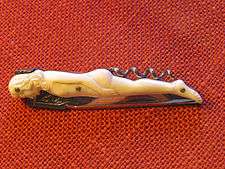Laguiole knife
The Laguiole knife (French pronunciation: [laɡjɔl], locally [lajɔl]) is originally a high-quality traditional Occitan pocket-knife, originally produced in the "knife-city" of Thiers where 70% of the French cutting tool production comes from, and in the small village of Laguiole, both located in the Massif central region of France. "Laguiole" is neither a trademark nor a company name. Rather, the name "Laguiole" became associated with a specific shape of a traditional knife common to this area.
History
The ancestor of the laguiole is most likely the Arabo-Hispanic clasp knife of Andalusian Spain, the navaja.[1][2][3] Migrations of men, particularly shepherds and cattle herders, between Catalan Spain and southern France in summer and winter introduced the navaja to France.[2] The Arabo-Hispanic design of the navaja was merged with that of local folding knives represented by older patterns such as the Capuchadou; the result became the laguiole. The laguiole was first designed in 1829 by Jean-Pierre Calmels. His concept of the knife became the pattern for this style, with the forged "bee" symbol emerging as a distinctive trademark. In 1840, the first awl or trocar (a surgical instrument used to puncture body cavities and relieve the suffering of cattle and other animals with bloat) was added to the some laguiole knife patterns. In 1880, some models of the laguiole began featuring a corkscrew, in response to demands from the Auvergne bars and restaurants owners in Paris.
Design

All laguiole knives feature a slim, sinuous outline. They are about 12 cm long when closed, with a narrow, tapered blade, steel backspring (slipjoint) and a high quality of construction. Traditionally the handle was made of cattle horn; however, nowadays other materials are sometimes used. These materials include French woods, exotic woods from all around the world, and fossilised mammoth ivory from Alaska or Siberia. The French designer Philippe Starck re-designed Laguiole knives using aluminium, but it was only a revival of a 1910 model. The blade is often made of Stainless steel or High-carbon steel, with XC75 steels being 0.75% carbon made and XC100 being 1% carbon.
The traditional laguiole utilizes a single blade, but sometimes a corkscrew or some other implement is added. This necessitates an even slimmer cutaway handle, the shape of which is fancifully known as the "lady's leg", the bolster at the base resembling a foot. A 'Shepherd's Cross' consisting of 6-8 inlaid metal wires forming a cross can be found on the handle of some laguioles from the end of the 19th century to the present day. This embellishment is a reference to a legend of Catholic shepherds in need of a cross for prayer during their seasonal migrations between the mountains and the plains. Far from any chapel or cathédrale, the shepherd would thrust his opened laguiole blade-down into the earth, exposing the visible cross on the handle for purposes of prayer.
There is much mythology about the insect depicted on the spring. A legend identifies the design as that of a bee was granted by Napoleon in recognition of the courage of local soldiers. The "bee" on the laguioles knives came after World War II while Napoleon was dead more than a century ago. Technically, "la mouche" (the fly) is the part who's holding the spring tight. Ancient laguiole knives feature many kind of decorated springs which doesn't necessarily feature insects.
There are about 109 production steps for a one-piece laguiole, about 166 for a two-piece one, and about 216 for a three-piece model.
The name Laguiole has since been used as a trademark designation for various other implements, so that one can now buy, for example, a "Laguiole" corkscrew, spoon, or steak-knife set.
Production sites
As Laguiole designates a type of knife and is not a brand or trade name of cutlery, Laguiole knives are manufactured globally. This has caused the market to be flooded with inexpensive knives made in Asia. Quality Laguiole knives are handcrafted in France by skilled workers. The French production is shared between the cutlery hub town of Thiers, and the village of Laguiole: and these places have worked together for more than 150 years. A quality manufacturer will proudly emboss his trademark or signature into the steel of his knives. "Made in France" will often be embossed as well. This is the origin's guarantee.
References
- ↑ Flock, Jean-Marie, Van Osselaer, Pierre, and McHoul, Alec, Visual Identities, New York: Continuum International Publishing Group, ISBN 0-8264-4739-2 (2005), p. 151
- 1 2 Lecoutre, Fabien, Rubat, Baptiste, Engelen, Barth, and Engelen, Cécile, Le Petit Futé La France à moto!, Paris, FR: Les Nouvelles Editions l'Université (2008), p. 540
- ↑ Pacella, Gérard, Couteaux de nos Terroirs, Paris: Editions de Borée - Terres Blues, ISBN 2-84494-858-8 (2005), p. 17
External links
- History of the Laguiole knife
- The Laguiole knife museum's website
- Handcrafting pictures and videos for Laguiole knives
- Manufacturing a Laguiole knife
- Forge de Laguiole - Forge de Laguiole - Manufacturer in the village of Laguole
- Laguiole Honore Durand - Honore Durand - Manufacturer in the village of Laguiole